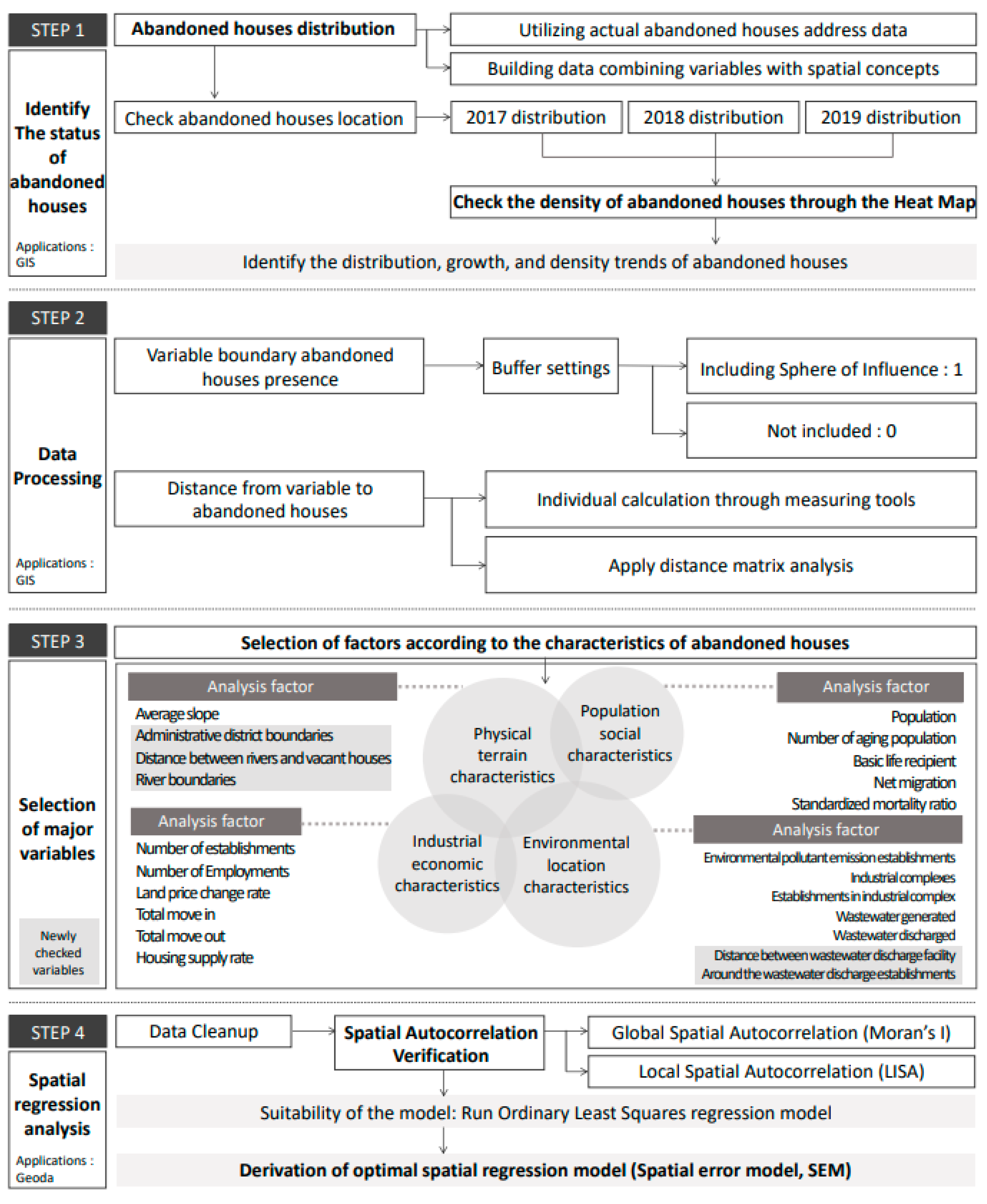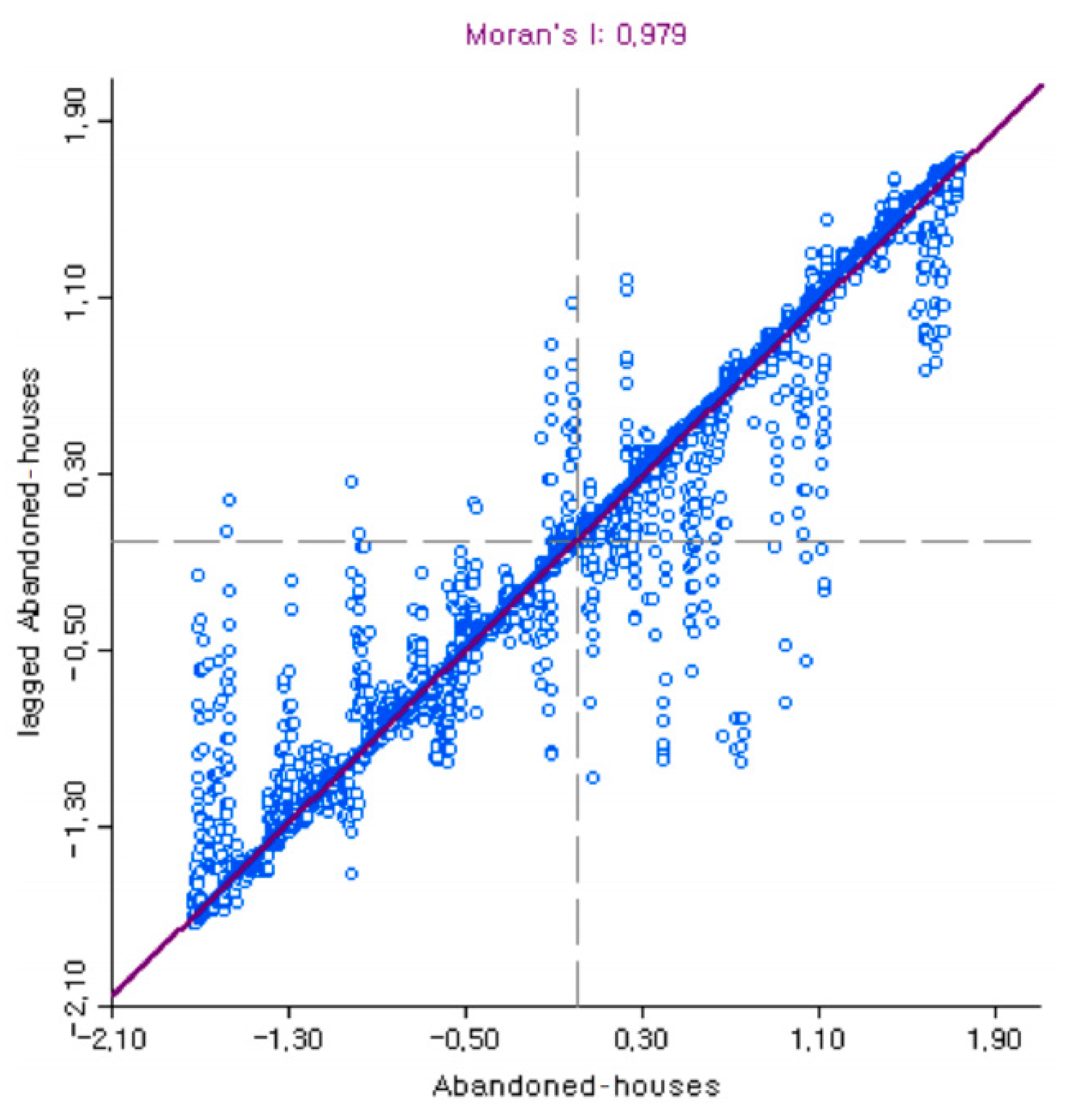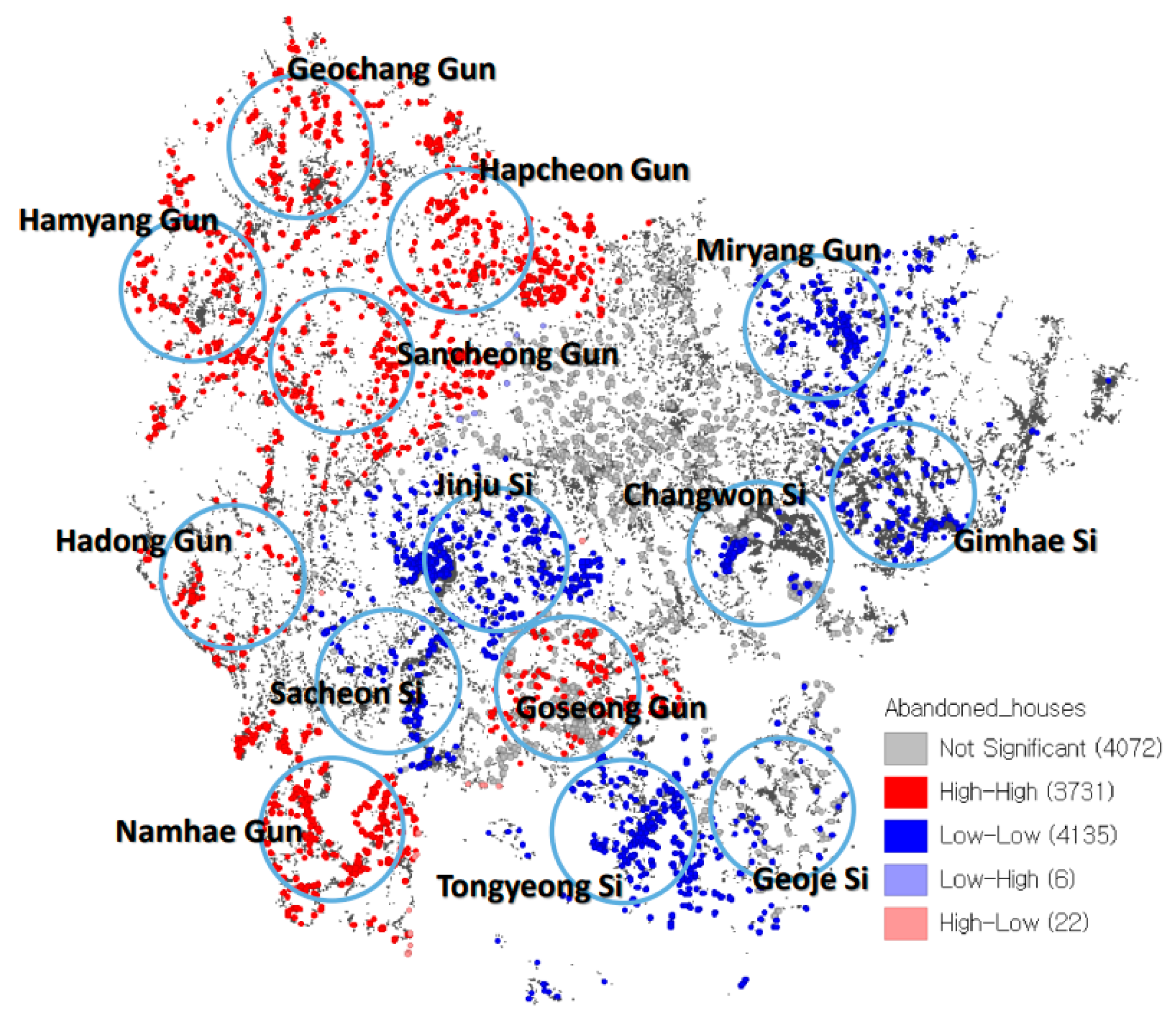Spatial Analysis of Abandoned Houses and Their Influencing Factors in South Korea
Abstract
:1. Background and Purpose of the Study
2. Methods
2.1. Scope of Study
2.2. Method of Study
3. Literature Review
3.1. Study of the Housing Abandonment
3.2. Study of the Causes of Housing Abandonment
4. Distribution of Abandoned Houses in Gyeongsangnam-do
4.1. Distribution and Density of Abandoned Houses
4.2. Data Construction and Variable Selection
4.2.1. Data Construction
4.2.2. Selection of Variables
5. Results and Discussion
5.1. Analysis of Variables Affecting Housing Abandonment
5.2. Result of Analyzing the Factors Influencing Housing Abandonment
6. Conclusions
Author Contributions
Funding
Institutional Review Board Statement
Informed Consent Statement
Data Availability Statement
Acknowledgments
Conflicts of Interest
References
- Urban Regeneration Information System. Available online: https://www.city.go.kr/index.do (accessed on 3 June 2021).
- Cohen, J.R. Abandoned Housing Exploring Lessons from Baltimore. Hous. Policy Debate 2001, 12, 415–448. [Google Scholar] [CrossRef]
- Schilling, J.M. The Revitalization of Vacant Properties: Where Broken Windows Meet Smart Growth; International City Management Association: Washington, DC, USA, 2002. [Google Scholar]
- Silverman, R.M.; Yin, L.; Patterson, K.L. Dawn of the dead city: An exploratory analysis of vacant addresses in Buffalo, NY 2008–2010. J. Urban Aff. 2013, 35, 131–152. [Google Scholar] [CrossRef]
- Morckel, V.C. Empty neighborhood: Using constructs to predict the probability of housing abandonment. Hous. Policy Debate 2013, 23, 469–496. [Google Scholar] [CrossRef]
- Lee, H.Y.; Lee, Y.S. Development of spatial decision support system for promoting the community-specific reuse of vacant houses. J. Korean Urban Geogr. Soc. 2017, 20, 29–43. [Google Scholar] [CrossRef]
- Kim, H.J.; Seong, E.Y.; Yeo, K.H. Exploring predominant neighborhood factors for proactive management of vacant houses—Focused on busan metropolitan city. J. Urban Des. Inst. Korea Urban Des. 2020, 21, 137–150. [Google Scholar] [CrossRef]
- Mallach, A. Bringing Buildings Back: From Abandoned Properties to Community Assets: A Guidebook for Policymakers and Practitioners; Rutgers University Press: New Brunswick, NJ, USA, 2006. [Google Scholar]
- Keenan, P.; Lowe, S.; Spencer, S. Housing abandonment in inner cities: The politics of low demand for housing. Hous. Stud. 1999, 14, 703–716. [Google Scholar] [CrossRef]
- Lee, D.Y. Investigating drivers of housing vacancy in old town incheon using multi-level analysis. J. Cadastre Land Inf. 2020, 50, 237–254. [Google Scholar]
- Han, S.K. Spatial Characteristics and the Fixation Process of the Vacant Abandoned Properties in Iksan City. Master’s Thesis, Seoul National University, Seoul, Korea, 2016. [Google Scholar]
- Nam, J.H. The reason of vacant houses’ generation and the method of management. J. Reg. Stud. 2016, 22, 187–215. [Google Scholar]
- Lim, Y.K.; Lim, H.S. Neighborhood Regeneration Policy Proposal on the Revitalization and Reclamation of Vacant Urban Spaces; Architecture & Urban Research Institute: Sejong-si, Korea, 2012. [Google Scholar]
- Morckel, V.C. Spatial characteristics of housing abandonment. Appl. Geogr. 2014, 48, 8–16. [Google Scholar] [CrossRef]
- Immergluck, D. Examining changes in long-term neighborhood housing vacancy during the 2011 to 2014 U.S. national recovery. J. Urban Aff. 2015, 38, 607–622. [Google Scholar] [CrossRef]
- Jung, S.Y.; Jun, H.J. Exploring spatial dependence in vacant housing growth. J. Korea Plan. Assoc. 2019, 54, 89–102. [Google Scholar] [CrossRef]
- Bassett, E.M.; Schweitzer, J.; Panken, S. Understanding Housing Abandonment and Owner Decision-Making in Flint, Michigan: An Exploratory Analysis; Lincoln Institute of Land Policy: Cambridge, UK, 2006. [Google Scholar]
- Molly, R. Long-term vacant housing in the United States national recovery. Reg. Sci. Urban Econ. 2016, 59, 118–129. [Google Scholar] [CrossRef] [Green Version]
- Kamata, Y.; Kang, J.E. Empirical comparative analysis of trends and factors affecting vacant houses in Korea and Japan. J. Korea Plan. Assoc. 2020, 55, 56–72. [Google Scholar] [CrossRef]
- Kim, S.Y.; Kim, S.H. A study on the impact of regional characteristics on vacant rate changes—For Gwangju Metropolitan city. J. Korea Real Estate Manag. Rev. 2019, 20, 285–317. [Google Scholar]
- Kim, H.J.; Han, H.K.; Yeo, K.H. Effects of regional characteristics on housing abandonment: Focused on demographic change and residential environment. Korean J. Urban Stud. 2018, 49, 123–144. [Google Scholar]
- Lee, H.O.; Lim, J.H. Analysis of residential environment factors that affect housing vacancy occurrence-with Jeollanam·buk-do as the cent. Korean Community Dev. Assoc. 2018, 43, 41–54. [Google Scholar]
- Noh, M.J.; Yoo, S.J. A study on the cause of abandoned vacant houses. Korea Real Estate Rev. 2016, 26, 7–21. [Google Scholar]
- Sternlieb, G.; Burchell, R.W.; James, F.J.; Hughes, J.W. Housing abandonment in the urban core. J. Am. Inst. Plan. 1974, 40, 321–332. [Google Scholar] [CrossRef]
- Scafidi, B.P.; Schill, M.H.; Wachter, S.M.; Culhane, D.P. An economic analysis of housing abandonment. J. Hous. Econ. 1998, 7, 287–303. [Google Scholar] [CrossRef]
- Hillier, A.E.; Culhane, D.P.; Smith, T.E.; Tomlin, C.D. Predicting housing abandonment with the Philadelphia neighborhood information system. J. Urban Aff. 2003, 25, 91–106. [Google Scholar] [CrossRef] [Green Version]
- Kim, K.H.; Han, E.J.; Shon, S.Y. Identifying influential factors to residential vacancy in Seoul based on a geographically weighted lasso model. J. Korean Inst. Ind. Eng. 2018, 44, 54–68. [Google Scholar]
- Park, J.I.; Oh, S.K. Spatial pattern and causative factor analysis of vacant housing in Daegu, South Korea using individual-level building DB. J. Korean Reg. Sci. Assoc. 2018, 34, 35–47. [Google Scholar]
- Perry, C. The neighborhood unit formula in branch. In Urban Planning Theory; Melville, C.B., Ed.; Dowden, Hutchinson & Ross, Inc.: Stroudsburg, PA, USA, 1975; p. 596. [Google Scholar]
- Ahn, Y.J. The effect of physical environments in neighborhood on residential satisfaction of public central apartment housings. GRI Rev. 2019, 21, 241–260. [Google Scholar]
- Barton, H. Sustainable Communities, the Potential for Eco-Neighborhoods; Earthscan: London, UK, 2000. [Google Scholar]
- Boarnet, M.G. Longer view: A broader context for land use and travel behavior, and a research agenda. J. Am. Plan. Assoc. 2011, 77, 197–213. [Google Scholar] [CrossRef]
- Cervero, R.; Duncan, M. Walking, bicycling and urban landscapes—Evidence from the San Francisco Bay Area. Am. J. Public Health 2003, 93, 1478–1483. [Google Scholar] [CrossRef]
- Kim, H.C.; Ahn, K.H.; Kwon, Y.S. The effects of residential environmental factors on personal walking probability—Focused on Seoul. J. Urban Des. Inst. Korea Urban Des. 2014, 15, 5–18. [Google Scholar]
- Kim, J.C.; Cho, J.S.; Seo, E.S.; Kim, J.W.; Yoo, Y.J.; Kim, S.H.; Park, M.J.; Hwang, J.M. Accurately Investigation Soil Measuring Network Points; Daegu Regional Environment Agency, Ministry of Environment, Keimyung Cultural University Industry-University Cooperation Foundation: Daegu, Korea, 2018. [Google Scholar]
- Park, J.W.; Lee, S.I.; Lee, E.P.; Kim, U.J.; Kim, M.J.; Lee, J.M.; Noh, J.Y.; Kim, Y.S.; Lee, M.A.; Yoo, Y.H. Evaluation of vegetative damage and soil pollution in the forest damage area of Yeongpung Seokpo Smelter. Korean J. Environ. Biol. Conf. 2020, 11, 136. [Google Scholar]
- Lee, D.Y. A study on the factors contributing to emerging vacant houses and countermeasures according to the neighborhood characteristics in the old city center of Incheon. J. Korean Urban Geogr. Soc. 2019, 22, 127–142. [Google Scholar] [CrossRef]
- Na, J.Y.; Lee, D.H. Current status and countermeasure for empty houses in metropolitan cities. KIEAE J. Acad. Present. Conf. 2016, 1, 8–9. [Google Scholar]
- Jang, M.J.; Kwon, S.M. An Analysis of the Determinants of Vacant Housing Occurrence. J. Korean Urban Manag. Assoc. 2021, 34, 77–96. [Google Scholar] [CrossRef]








| Administrative Division | 2017 | 2018 | 2019 | Changed Ratio of Abandoned Houses Compared to the Previous Year | |||
|---|---|---|---|---|---|---|---|
| Number of Houses | Ratio of Abandoned House to Total Number of Houses | Number of Houses | Ratio of Abandoned House to Total Number of Houses | Number of Houses | Ratio of Abandoned House to Total Number of Houses | ||
| Changwon-si | 858 | 0.257 | 986 | 0.287 | 1250 | 0.353 | 1.1 |
| Jinju-si | 903 | 0.786 | 967 | 0.814 | 1180 | 0.949 | 2.3 |
| Tongyeong-si | 545 | 1.111 | 725 | 1.419 | 1278 | 2.314 | 2.1 |
| Sacheon-si | 127 | 0.281 | 141 | 0.305 | 243 | 0.483 | 6.3 |
| Gimhae-si | 143 | 0.084 | 169 | 0.097 | 282 | 0.156 | 3.4 |
| Miryang-si | 256 | 0.556 | 411 | 0.879 | 763 | 1.591 | 1.3 |
| Geoje-si | 251 | 0.271 | 309 | 0.317 | 384 | 0.379 | 0.3 |
| Yangsan-si | 12 | 0.010 | 18 | 0.014 | 33 | 0.026 | 1.5 |
| Uiryeong-gun | 111 | 0.847 | 308 | 2.293 | 656 | 4.374 | 0.8 |
| Haman-gun | 414 | 1.473 | 533 | 1.894 | 581 | 2.036 | -0.6 |
| Changnyeong-gun | 106 | 0.385 | 154 | 0.558 | 259 | 1.004 | 1.2 |
| Goseong-gun | 472 | 1.993 | 700 | 2.927 | 1394 | 5.638 | 2.0 |
| Namhae-gun | 455 | 2.049 | 583 | 2.594 | 959 | 4.170 | 1.9 |
| Hadong-gun | 162 | 0.810 | 190 | 0.927 | 310 | 1.430 | 3.3 |
| Sancheong-gun | 117 | 0.704 | 170 | 1.019 | 325 | 2.187 | 1.9 |
| Hamyang-gun | 214 | 1.177 | 323 | 1.768 | 501 | 2.568 | 0.6 |
| Geochang-gun | 306 | 1.155 | 414 | 1.523 | 462 | 1.659 | -0.6 |
| Hapcheon-gun | 569 | 2.463 | 742 | 3.192 | 1106 | 4.682 | 1.1 |
| Total | 6021 | 16.411 | 7843 | 22.825 | 11,966 | 35.998 | 1.3 |
| Classification | Variable | Source of data | |
|---|---|---|---|
| Dependent variable | Number of abandoned house | Aggregated data individually surveyed by public of Gyeongsangnam-do local governments | |
| Independent variables | Characteristics of physical topography | Presence of abandoned houses on the boundaries of administrative divisions | GIS buffer analysis (based on 400 m) |
| Distance from a river to the abandoned houses | GIS distance measurement | ||
| Presence of abandoned houses in the vicinity of a river | GIS buffer analysis (based on 400 m) | ||
| Average slope | Korea National Spatial Data Infrastructure Portal | ||
| Characteristics of environmental location | Number of businesses discharging pollutants | KOSIS, Environmental statistics: eup, myeon, dong (2019) | |
| Number of industrial complexes | |||
| Number of businesses in the industrial complex | |||
| Amount of wastewater generated | |||
| Amount of wastewater discharged | |||
| Distance to abandoned houses in the vicinity of a wastewater treatment facility | GIS buffer analysis and distance matrix | ||
| Presence of abandoned houses in the vicinity of a wastewater treatment facility | GIS buffer analysis (based on 4000 m) | ||
| Characteristics of population demographic | Population | KOSIS, Regional statistics: eup, myeon, dong (2019) | |
| Population of the elderly over 65 | |||
| Number of people receiving the National Basic Living Security Allowance | |||
| Net migration | |||
| Standardized mortality ratio | Gyeongsangnam-do Regional Health Care Basic Statistics Collection: eup, myeon, dong (2019) | ||
| Characteristics of industry and economy | Number of businesses | KOSIS, Economic statistics: eup, myeon, dong (2019) | |
| Number of employees | |||
| Fluctuation rate of land price | Ministry of Land, Infrastructure and Transport: individually announced land price (2019) | ||
| Housing supply ratio | KOSIS, Housing statistics: eup, myeon, dong (2019) | ||
| Total in-migration | KOSIS, Regional statistics: eup, myeon, dong (2019) | ||
| Total out-migration | |||
| Moran’s Index | 0.9793 |
| Expected Index | −0.0001 |
| Mean | 0.0000 |
| SD | 0.0049 |
| z-value | 198.1169 |
| Pseudo p-value | 0.001 |
| Classification | Variables | Spatial Error Regression Model (SEM) |
|---|---|---|
| Spatial effects | λ(Lambda) | 0.91 *** |
| Constant | −13.875 *** | |
| Characteristics of physical topography | Presence of abandoned houses on the boundaries of administrative divisions | 13.437 *** |
| Distance from a river to the abandoned houses | −0.001 * | |
| Presence of abandoned houses in the vicinity of a river | −3.917 ** | |
| Average slope | 6.037 *** | |
| Characteristics of environmental location | Number of businesses discharging pollutants | 0.088 *** |
| Number of industrial complexes | 2.023 | |
| Number of businesses in the industrial complex | 0.300 * | |
| Amount of wastewater generated | 2.097 *** | |
| Amount of wastewater discharged | 2.177 *** | |
| Distance to abandoned houses in the vicinity of a wastewater treatment facility | −0.001 ** | |
| Presence of abandoned houses in the vicinity of a wastewater treatment facility | 3.048 * | |
| Characteristics of population demographic | Population | −0.005 |
| Population of the elderly over 65 | 0.049 *** | |
| Number of people receiving the National Basic Living Security Allowance | 0.044 *** | |
| Net migration | −0.011 | |
| Standardized mortality ratio | 0.383 * | |
| Characteristics of industry and economy | Number of businesses | −0.042 *** |
| Number of employees | −0.002 | |
| Fluctuation rate of land price | −8.971 * | |
| Housing supply ratio | −0.001 | |
| Total in-migration | 0.029 *** | |
| Total out-migration | 1.132 *** | |
Publisher’s Note: MDPI stays neutral with regard to jurisdictional claims in published maps and institutional affiliations. |
© 2021 by the authors. Licensee MDPI, Basel, Switzerland. This article is an open access article distributed under the terms and conditions of the Creative Commons Attribution (CC BY) license (https://creativecommons.org/licenses/by/4.0/).
Share and Cite
Joo, H.; Lee, S. Spatial Analysis of Abandoned Houses and Their Influencing Factors in South Korea. Appl. Sci. 2021, 11, 8576. https://doi.org/10.3390/app11188576
Joo H, Lee S. Spatial Analysis of Abandoned Houses and Their Influencing Factors in South Korea. Applied Sciences. 2021; 11(18):8576. https://doi.org/10.3390/app11188576
Chicago/Turabian StyleJoo, Heesun, and Soyeong Lee. 2021. "Spatial Analysis of Abandoned Houses and Their Influencing Factors in South Korea" Applied Sciences 11, no. 18: 8576. https://doi.org/10.3390/app11188576
APA StyleJoo, H., & Lee, S. (2021). Spatial Analysis of Abandoned Houses and Their Influencing Factors in South Korea. Applied Sciences, 11(18), 8576. https://doi.org/10.3390/app11188576






